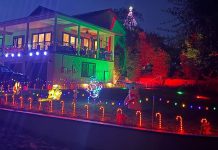Disaster and beauty go together
We called it
”
Pine Valley,
”
a name that never made it to the maps.
There was a camp there, run by the YMCA, isolated and quiet, but
complete with cabins and a lodge, in the western Tehachapis just
north of the line between Ventura and Kern counties.
The sesquicentennial of California’s biggest quake
We called it “Pine Valley,” a name that never made it to the maps.
There was a camp there, run by the YMCA, isolated and quiet, but complete with cabins and a lodge, in the western Tehachapis just north of the line between Ventura and Kern counties.
In the summer I swam, rode horses, and played capture the flag across a panorama that felt as big as the Old West itself. I may have made a lanyard or two.
In the winter we returned with our fathers, slept in the chilly cabins, ate scrambled eggs for breakfast, drank hot chocolate in the lodge, and sledded wherever a patch of snow could be found.
And each spring, I sold candied peanuts door to door to earn my way back to paradise.
Today Pine Valley is gone, a road rammed through it to provide access to the vacation homes of rich Angelinos. It has been erased, as if struck by an earthquake. It could easily have happened that way.
After all, that’s what created the valley in the first place.
Pine Valley is a steep, V-shaped canyon below San Emigdio mountain, in the San Andreas Rift Zone. It isn’t near the fault. It is the fault.
And it was the geographical center of what, according to the California Geological Society, was the most powerful earthquake in California history, bigger even than the 1906 San Francisco earthquake: the Fort Tejon quake.
On Tuesday, Jan. 9, we commemorate its 150-year anniversary.
Accounts differ as to the time the quake struck – most say around 8:20 a.m. that Friday morning in 1857. The 7.9 temblor – the CGS puts the 1906 San Francisco quake at 7.8 – was preceded by a few hours by at least two significant foreshocks of greater than 5.7. The epicenter was placed near Parkfield, in southern Monterey County, but the slippage extended southeastward for some 225 miles, all the way to San Bernardino County. The center of that line was near Fort Tejon – somewhere around Pine Valley.
People in San Francisco and much of Southern California felt the quake, but because the area most affected was sparsely populated, only two deaths were reported, one in Los Angeles and the other in Fort Tejon, which was reduced to rubble.
It is reported to have gone on for at least a minute, possibly as long as three. Land along the fault shifted an average of 15 feet, with a maximum rupture of 30 feet at some points.
Several rivers, including the Kern, were reported to swirl and flow backwards. One story, from a rancher living near Tule Lake in Kings County, recounted how the shallow lake rose up like an ocean and surged over its banks, leaving fish behind on shore for three miles when the water receded. He fled on his terrified horse over the quaking earth.
Some artesian wells went dry while new ones, in Santa Barbara and elsewhere, flowed for the first time. Steam bellowed up from the earth at San Fernando Pass, while the mission in Ventura was severely damaged.
Earthquake history tends to focus on the disastrous, but it is worth bearing in mind that such catastrophes are responsible for much of this miraculous state’s varied and dramatic landscape. Times have changed, but the earth’s habits haven’t. As fires are good for forests, earthquakes rend and rip and create places of beauty. Earthquakes are the trembling hand dealt us by Mother Nature.
Pine Valley, that wilderness of my childhood, wasn’t carved by a river or gouged out by a glacier. It became a beautiful valley, a cleft in the pallet of the Transverse Range, because the earth separated itself that way, in that place, through the Tejon quake and no doubt dozens more like it over millennia. It was humans who ruined it with a noisy road.
The price of the Tejon quake was small, because the state was sparsely populated then. And if another Fort Tejon-size quake hit – even in Fort Tejon – we could expect much greater devastation in this much more populous California.
But though it may give pause to think it, without this force we malign and fear, without the upheavals and gaping chasms that have swallowed up the unlucky – without, indeed, the awful destruction and death, we would not have had places like Pine Valley.
We would not, in fact, have California.









